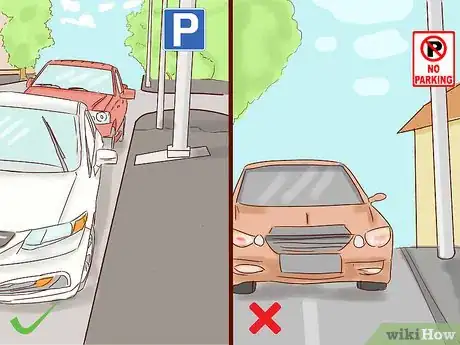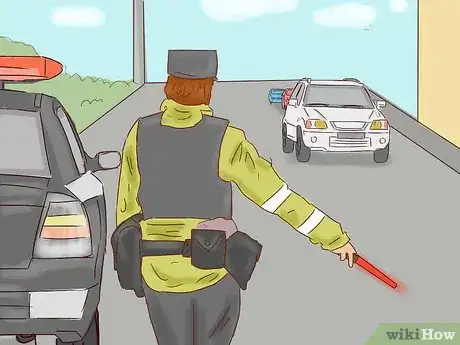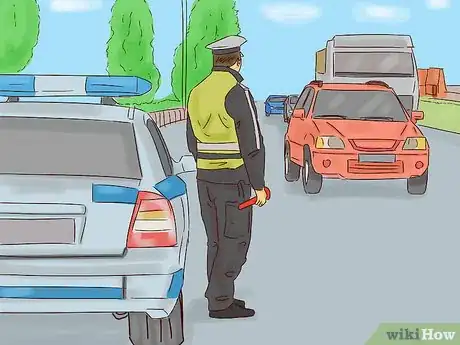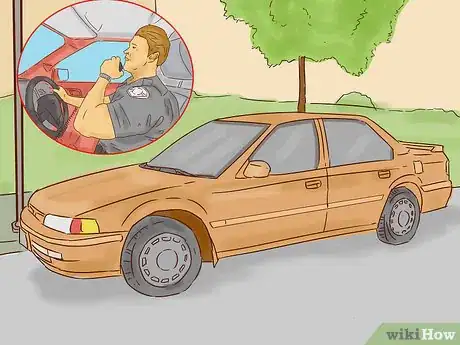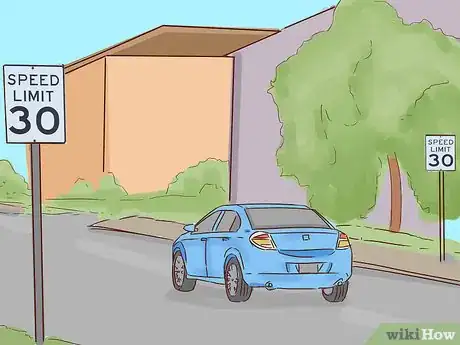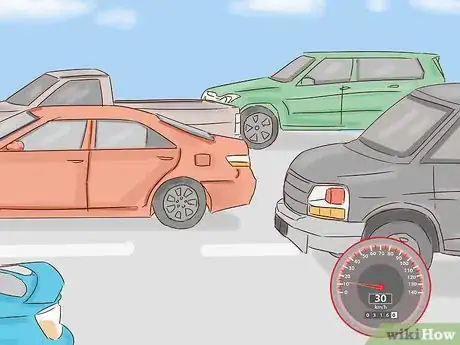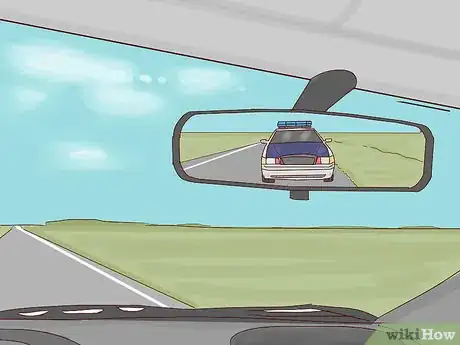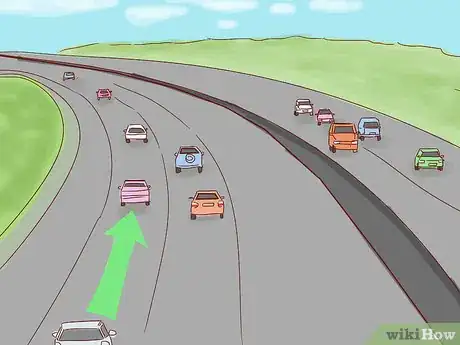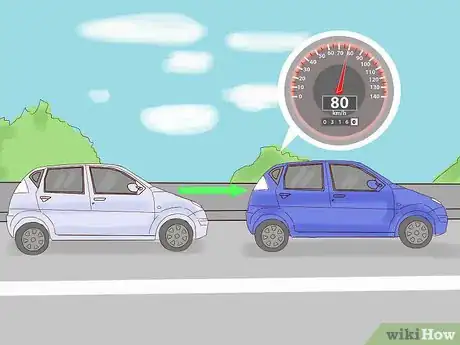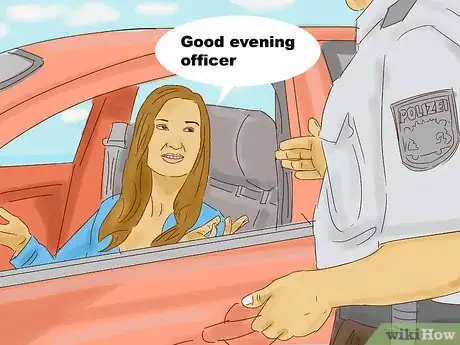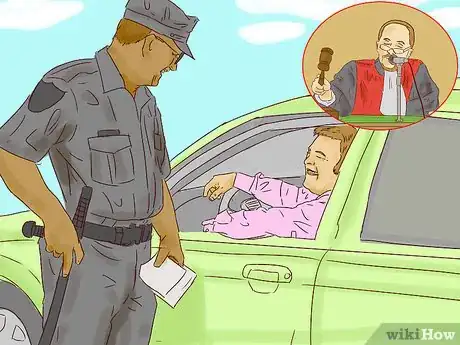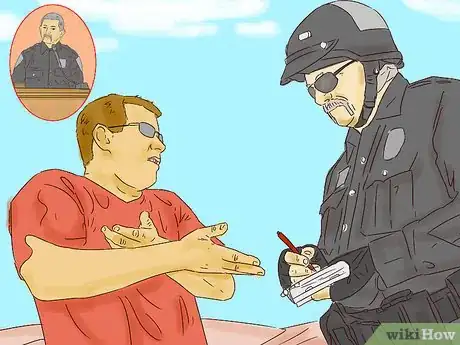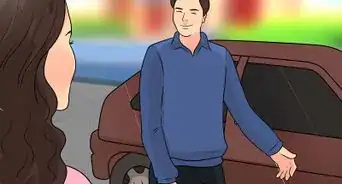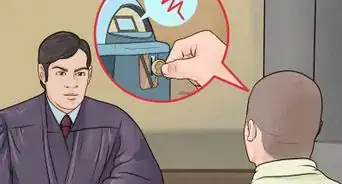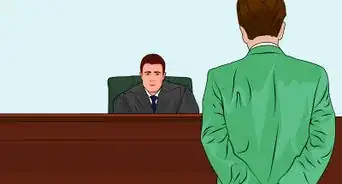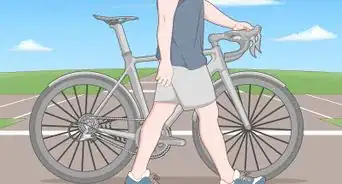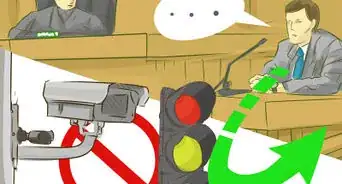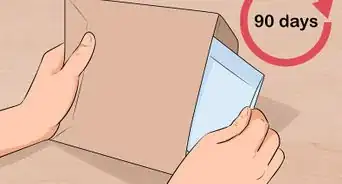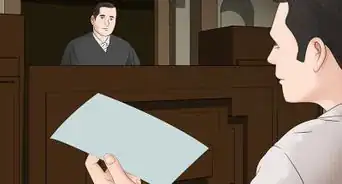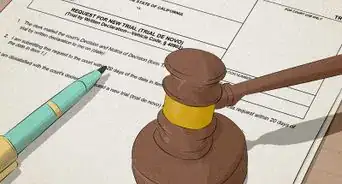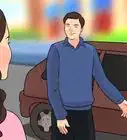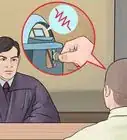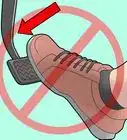This article was co-authored by Simon Miyerov. Simon Miyerov is the President and Driving Instructor for Drive Rite Academy, a driving academy based out of New York City. Simon has over 8 years of driving instruction experience. His mission is to ensure the safety of everyday drivers and continue to make New York a safer and efficient driving environment.
There are 10 references cited in this article, which can be found at the bottom of the page.
This article has been viewed 265,073 times.
Tens of millions of traffic tickets are issued each year, raking in big revenue for state and local coffers. For the motorist, even one speeding ticket can raise your insurance premiums for several years, and multiple violations can push your rates through the roof. Fortunately, many tickets can be avoided with by following a few simple guidelines.
Steps
Drive Safely
-
1Obey the rules of the road. Don't break traffic laws, and you won't get ticketed. Ignorance is no excuse. Traffic laws also vary from state to state and even from town to town, so do some research if you're driving away from home.[1]
-
2Practice defensive driving. Aggressive or erratic driving can irritate other drivers and put both of you in danger. Even if you're not breaking any laws, weaving in and out of lanes and stopping or accelerating quickly can bring you unwanted attention from police. Consider taking a defensive driving course.[2]Advertisement
-
3Wear your seat belt. It's the law pretty much everywhere, and an iron-clad excuse for a sharp-eyed officer to pull you over.[3]
Catching Cops
-
1Watch for potential ambushes. Constantly scan the road ahead for parked cars and police cruisers on the road. You can't just look for the classic police car, though; departments everywhere are mixing up their fleets, so that SUV or sports car up ahead may be trouble. A few tips to spot these cars:
- Look for roof lighting. Your brain should pop up a red flag anytime it sees any sort of junk on top of a car.
- Look for a spotlight on the drivers side of the vehicle. Only police package vehicles have this option.
- By law, officers are not allowed to endorse any ideology or group on their cars. The cars are owned by the city, so you'll be hard pressed to find a police car with a "Total Princess" sticker on the bumper.
- Police license plates are made differently than regular plates. In some cases, they'll actually say EXEMPT. Find out what their license plates actually look like in your state.
- Pay close attention to the brake light that most cars have at the top center of the rear window. Cops' center lights are larger because they function as blue and white lights as well. An easy giveaway is if that center brake light is visible but does not light up red when braking.
- Cruisers often have multiple antennas on them.
-
2Get a radar/laser detector. If you're intent on being a speed demon, a combination laser/radar detector can help you hit the brakes in time. Be careful, though: detectors are illegal to have in your vehicle in Virginia, Washington, D.C., US Military bases and in many countries. They're far from 100% effective, and if you do get pulled over, you won't earn any brownie points when the officer sees the detector.[5]
-
3Remember that you can't always see police along the road. It's prudent to slow down a bit before potential hiding spots such as exit ramps, blind curves, or stands of trees, and be especially wary around potential speed traps, such as stretches of road undergoing work or places where the posted speed limit decreases. When you see a reduction in the speed limit, make sure to slow to the new limit before you reach the sign: police know this is one of the best place to find speeders.
-
4Watch out for speed cameras. More localities are adopting photo radar, a system which automatically photographs the license plate and driver's face of a vehicle which the radar determines is speeding. These systems are sometimes mounted inside a van which will be parked alongside the road, or they are often mounted permanently at trouble spots, such as intersections that have a lot of accidents.
- Cameras are also used to photograph vehicles that run red lights or travel in the carpool lane without passengers. You can usually see these cameras if you look hard enough, especially if you travel the same route frequently.
- You may be able to find the location of permanent cameras in your area via local government websites or internet search.
-
5Be aware of other cars. The worst thing to do after narrowly avoiding the cop with a laser gun is to fly past the next cop driving on the same road as you. Be aware of every car in your vicinity.
-
6Look inside the suspicious cars if you can. You might see a cage separating the front and back seats. Or you might see the officer's uniform.
-
7Get to know the roads you regularly travel. Police frequently choose the same hiding places over and over again, so make a mental note when you see a cruiser parked along the road and make sure you're following the speed limit next time you come to that point.
-
8Beware of multiple cruisers. If you see another motorist stopped by a police cruiser, don't assume the coast is clear. Slow down to the speed limit, and stay that way for another mile or two. It's increasingly common for police to set up speed traps with several officers clustered in a short span of road.
-
9Check your rear-view mirror often. This will minimize the chance that a patrol car will sneak up on you. Also, if an officer pulls up behind you at night with his or her headlights off chances are that he/she is about to pull you over, so be prepared to stop.
Specific to Speeding
-
1Where possible, drive the speed limit. Know, however, that the posted limit applies only to ideal conditions.[6] Drive 5 or 10 mph (8.0 or 16.1 km/h) under if it is raining or there is snow/ice on the ground.
-
2Stay out of the “fast lane.” Drivers in the “fast lane” (the left-most lane on U.S. multi-lane highways) are more likely to be ticketed not only because they're typically driving faster, but also because of the psychological element: they appear to be going faster simply because they're in the “fast lane”. In addition, many jurisdictions have laws that require you to drive in the right lane unless you are passing, so you can be ticketed for cruising in the left lane.
-
3Go with the flow of traffic. If you're going to speed, you're less likely to be ticketed if everybody else is doing it.[7] (However, if you are pulled over exceeding the speed limit, "going with the flow of traffic" cannot be used as an excuse for receiving a speeding ticket.) It's not uncommon in many areas for the posted speed limit to be something of a joke. If everybody's going 80 in a 70, chances are you can get away with it — in fact, if you're going significantly slower you may be a hazard—but if you treat that as a license to go 85, guess who'll get nabbed.[8]
-
4Pay attention to clues from other motorists, especially truckers. If you see brake lights up ahead, especially on that car that just blew by you, there may be a speed trap just out of your view, or a radar detector may be alerting the driver in front of you. It pays to watch the behavior of truckers, in particular, because truckers down the road can use CB radio to warn those behind them. Additionally, motorists going the opposite direction might flash their lights at you to warn you about a cop.[9]
-
5Find a guinea pig. Take notice of someone driving roughly the same speed as you and let them get a good distance ahead, then watch them for any sudden stops or other behavior that may indicate a speed trap.
Getting Pulled Over
-
1Be polite and know the protocol. If you do get pulled over, you may still be able to get away with a warning if you're courteous.[10]
- When the officer comes to your window, greet him or her with respectful words, such as "Good evening, officer." Do not use slang. Say "want to" instead of "wanna," and whatever you do, don't refer to police officers as cops. Following these tips will make you seem educated and sensible. The officer may not give you a ticket just because you don't seem buzzed or you seem like a respectable person who made a small error.
- Don't start arguments or act irritated or belligerent, and don't make dumb excuses.
- Be nice and you may get some pity. If you've already broken a traffic law, you can't make things any better by being a jerk.
- Make the police officer feel safe if you get pulled over. Police officers have a dangerous job, and they know that any routine traffic stop can turn life-threatening. If you can put an officer at ease, it make his or her job a little less stressful and he or she may thank you for it by letting you off with a warning.
- Pull over when you see the police officer signal for you to pull over. Look for a safe area where the officer can stand beside your car and not risk his own life with passing traffic.
- Pull into a parking lot if you can; but always signal to the officer to show that you aren't avoiding him. This can be accomplished by flipping on your right blinker. If you must pull over to the side of the road, the right shoulder is almost always safer for both you and the officer.
- Park your vehicle so that you cannot drive forward. For example, pull right up to a wall. Then the officer can park right behind you without worrying that you will try to drive away and escape.
- Turn off your car, and possibly remove the keys from the ignition.
- If it is nighttime, turn on as many interior lights as possible.
- Remain in the car. Do not move to leave the car at any time during the stop unless you are asked to do so.
- Sit still with your seatbelt on, and place your hands on the top of your steering wheel, in plain sight. Don't fidget around before the officer approaches the vehicle or at any time during the stop.
- The officer will request your driver's license, registration and insurance card. Leave your hands on top of the steering wheel. Describe to the officer where the papers are, and ask permission to get them. When the officer permits it, move slowly and deliberately to retrieve the documents. Avoid sudden movements that may make the officer feel you're reaching for a weapon.
- If an officer states you were speeding, it is OK to politely ask how they know. If the officer states that he used a radar gun, ask to see it. Most officers inadvertently turn the unit off once you are stopped - deleting the speed entry.
- If you got a ticket via a radar gun, ask to see the officers daily log. He or she would need to state they calibrated the unit prior to beginning their patrol.
-
2Avoid admissions of guilt (or don't). When the officer asks you if you know why you were pulled over, never admit to anything if you intend to later fight the ticket. If you do get a ticket, your admission can be used against you in court.
- If you think you might get away with a warning, you can try being completely honest. The officer may appreciate your honesty and be more likely to let you off with a warning. It's a tough choice to make, but do your best to analyze the situation and the officer's demeanor, and hopefully you'll make the right decision.
-
3Contest a ticket. If you can't avoid a ticket, consider fighting it through the legal system. Sometimes, just showing up indicates you are more responsible than other motorists. Dress well, and be prepared to argue your side of the case without emotion and with as much supporting material as you can provide. Depending on the judge and the jurisdiction, the judge may give you some leniency.[11]
-
4Don't think that the cop will be unlikely to appear in court if you challenge your ticket. Many jurisdictions pay overtime or more for time spent in court. In some circumstances since the officer is being paid overtime for being in court, he or she may act in your favor for dismissal of the ticket - that is, if you were polite and respectful when receiving the citation.
Warnings
- Be careful with trying to flirt your way out of a ticket. Some officers will play along, while others will be offended and come down harsher on you for this gamble.⧼thumbs_response⧽
- Being rude, obnoxious or demanding never helps. Be respectful. Try to chat with the officer and be polite.⧼thumbs_response⧽
- Be aware that in most jurisdictions, going 15 mph (24 km/h) over the speed limit not only counts as speeding, but qualifies you for a significantly more expensive reckless driving citation.⧼thumbs_response⧽
- Do not threaten the police officer with comments such as "I'll see you in court."⧼thumbs_response⧽
- The information in this article is not legal advice, and neither wikiHow nor the contributors to this article condone breaking any traffic laws. The best way to avoid getting a ticket is to drive within the law.⧼thumbs_response⧽
References
- ↑ Simon Miyerov. Driving Instructor. Expert Interview. 4 December 2019.
- ↑ https://driving-tests.org/beginner-drivers/what-is-defensive-driving/
- ↑ https://www.nhtsa.gov/risky-driving/seat-belts
- ↑ https://edition.cnn.com/2008/LIVING/wayoflife/07/23/aa.speeding.ticket/index.html
- ↑ https://www.youtube.com/watch?v=a8y4CWHht5I&app=desktop
- ↑ Simon Miyerov. Driving Instructor. Expert Interview. 4 December 2019.
- ↑ Simon Miyerov. Driving Instructor. Expert Interview. 4 December 2019.
- ↑ https://www.youtube.com/watch?v=ld0ptUlCcmE
- ↑ https://www.youtube.com/watch?v=ld0ptUlCcmE
